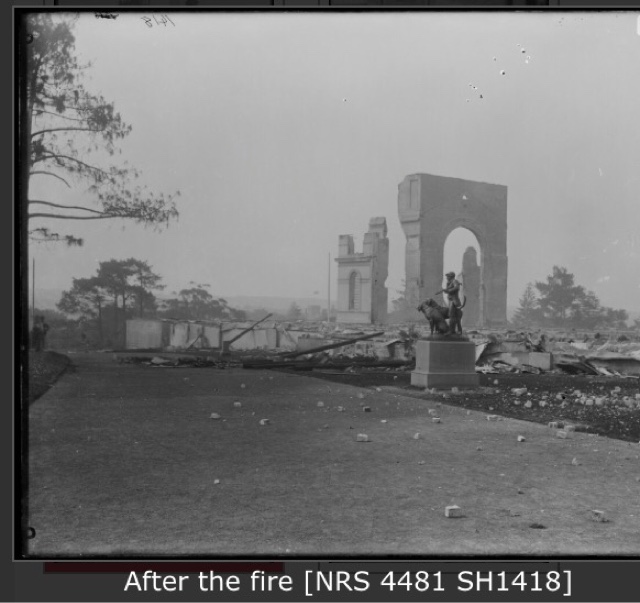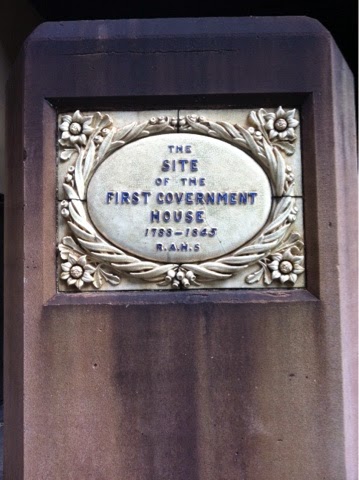Search This Blog
Tuesday, October 20, 2015
Sydney Centennial - 1888 - A Coming Of Age
Friday, October 16, 2015
Sydney Garden Palace after The Fire
The Sydney Garden Palace Gates were part of the entrance to the Sydney Garden Palace, a magnificent structure that once stood in the Royal Botanic Garden of Sydney, Australia. The gates are a remnant of the Garden Palace, which was a grand exhibition building that showcased the technological and cultural achievements of the late 19th century. Here's more information about the Sydney Garden Palace Gates:
The Garden Palace:
- The Sydney Garden Palace was a vast exhibition building constructed for the Sydney International Exhibition of 1879. The building was designed by colonial architect James Barnet and was situated within the Royal Botanic Garden.
- The Garden Palace was an impressive structure made of glass and iron, and it covered an enormous area. It housed a wide variety of exhibits, including displays of art, industry, science, and technology.
Gates and Entrance:
- The entrance to the Sydney Garden Palace was marked by grand gates that led visitors into the exhibition building.
- These gates were an integral part of the overall design, serving as an introduction to the opulent architecture and cultural treasures within the Garden Palace.
Destruction and Legacy:
- Tragically, the Sydney Garden Palace was destroyed by a fire on September 22, 1882, just a few years after the exhibition. The fire was a devastating loss, as the Garden Palace housed numerous irreplaceable artifacts and exhibits.
- The only remaining physical remnant of the Garden Palace is the sandstone and iron gates that once welcomed visitors into the grand exhibition building.
Current Location:
- The surviving gates were removed from their original location at the site of the Garden Palace's entrance and repositioned elsewhere in the Royal Botanic Garden.
- The gates serve as a historical artifact and a reminder of the grandeur that once existed on the grounds. They are an enduring link to a significant event in Sydney's history.
Cultural Significance:
- The Sydney Garden Palace and its gates hold cultural and historical importance, representing a brief yet impactful moment in Sydney's past.
- The gates symbolize the aspirations, achievements, and ultimately the loss associated with the Garden Palace and the exhibition it hosted.
Heritage Preservation:
- The surviving gates are carefully preserved to ensure their historical significance is not lost. They serve as a tangible connection to an event that showcased the global ambitions of a growing colonial city.
The Sydney Garden Palace Gates stand as a poignant reminder of an ambitious project that sought to celebrate progress and innovation. While the grand exhibition building itself was lost to fire, these gates endure as a lasting testament to the cultural, technological, and architectural aspirations of 19th-century Sydney.
Thursday, October 8, 2015
Sydney Garden Palace - Part 2
Sydney Garden Palace - Part 2
There are a few photos of the Crystal palace Located at the Royal Botanic Gardens in Sydney Australia. This magnificent structure was built to hole the World Expo in the 1880's. Unfortunately within a couple years of it being built, it burnt down.
It appears to be one of the most magnificent buildings in Sydney for the time, far outweighing the Queen Victroria building etc and other buildings in Sydney of that era. There are only a few photos left.
the Palace was composed almost entirely of iron and glass with wood used only in the fittings and floorboards. The construction used 2300 cast-iron girders, 358 wrought-iron trusses to support the roof, 325 kilometres of sash bars supporting glass weighing more than 406 tonnes and 3230 hollow cast-iron columns which, as well as being the primary supporting infrastructure, served as water pipes to carry off rainwater from the 54.7 kilometres of guttering.
The final structure was an impressive 563 metres long and 124 metres wide with a central transept 22 metres wide and rising to 32.9 metres, specially designed to enclose within the building a grove of tall elms that public opinion would not allow to be cut down. The structure covered over seven hectares of ground and enclosed 934 560 cubic metres of space while galleries added another two hectares to the floor area.
If opening day was a sensation the following weeks exceeded all expectations. Carried from the Midlands and the North by the newly inaugurated popular excursion trains and coastal steamers, visitors to the Exhibition came in numbers that first alarmed, then surprised and finally delighted the organisers. Men, women and children came, they came singly, they came in families, they came, in the end, in droves. On one day in October 109 915 people were admitted to the Exhibition.
Other statistics add to the legend of the Exhibition. It attracted no fewer than six million visitors during the 141 days it was open to the public—many from overseas; an incredible number considering a population much lower, and poorer, than today, and limited transport options—no international flights or coach tours! The Exhibition also achieved several other firsts, including the first public toilets—which brought in a substantial contribution of £1769 to the overall profit of £186 000—and it was the first, and possibly the last, to actually make a profit, part of which was used to provide London with a cultural and educational centre, including the famous Victoria and Albert Museum. The total value of the exhibits was estimated at about £2 million—not including the fantastic Koh-i-Noor (Mountain of Light) diamond, now part of the British crown jewels, and which was considered too difficult to value. The figures clearly show the Great Exhibition in its spectacular Palace was a resounding triumph.
Not surprisingly, the phenomenal success encouraged international emulation and the rest of the world quickly followed suit. Australia’s first international trade exhibition opened in Sydney in 1879. It was housed in a specially constructed large and ornate building called the Garden Palace on land now included in the Botanic Gardens. Unhappily it was destroyed by fire in 1882
Thursday, September 17, 2015
Arthur Phillip - First Fleet - King George III's Instructions
GOD SAVE THE KING
5. First Government House
First Government HouseConstruction Of The First Government House Was Commenced On May 15, 1788. Governor Phillip Moved In Ahortly Before June 4 1789. It Was The Residence of 8 Governors Until 1845
Saturday, September 5, 2015
National Day Of The Australian Flag - September 3rd
On September 3rd 1901.... 8 Months After The Australian Constitution was Signed ... the Australian Flag Was Flown For the First Time. Before That Each Colonial State had Its Own Version
















































